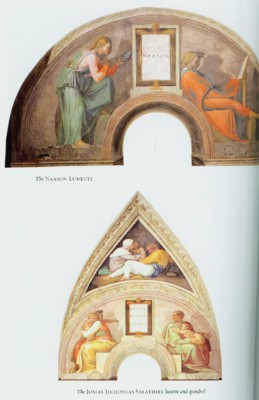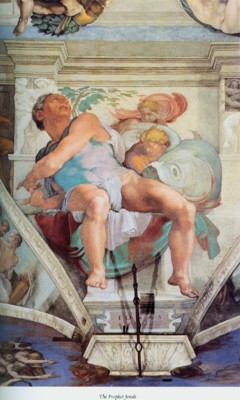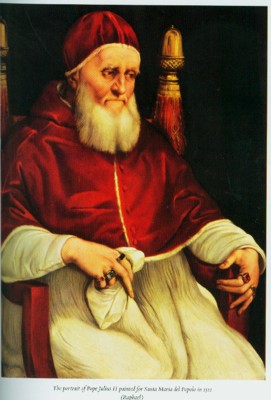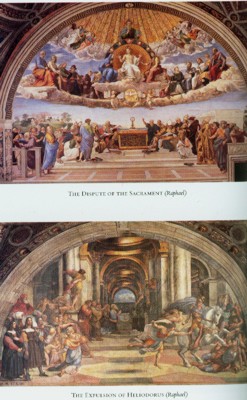













Michelangelo and the Pope’s Ceiling by Ross King.
NOTE: We have 75,000 books in our library, almost 10,000 different titles. Odds are we have other copies of this same title in varying conditions, some less expensive, some better condition. We might also have different editions as well (some paperback, some hardcover, oftentimes international editions). If you don’t see what you want, please contact us and ask. We’re happy to send you a summary of the differing conditions and prices we may have for the same title.
DESCRIPTION: Softcover: 373 pages. Publisher: Penguin Books; (2003). Size: 9¼ x 6½ x 1 inch; 1¼ pounds. In 1508, despite strong advice to the contrary, the powerful Pope Julius II commissioned Michelangelo to paint the ceiling of the newly restored Sistine Chapel. With little experience as a painter (though famed for his sculpture David), Michelangeo was reluctant to begin the massive project. Michelangelo and the Pope's Ceiling recounts the four extraordinary years Michelangelo spent laboring over the vast ceiling while the power politics and personal rivalries that abounded in Rome swirled around him. Battling against ill health, financial difficulties, domestic problems, the pope's impatience, and a bitter rivalry with the brilliant young painter Raphael, Michelangelo created scenes so beautiful that they are considered to be among the greatest masterpieces of all time. A panorama of illustrious figures converged around the creation of this magnificent work, from the great Dutch scholar Erasmus to the young Martin Luther. Ross King skillfully weaves them through his compelling historical narrative, offering uncommon insight into the intersection of art and history.
CONDITION: LIKE NEW. New (albeit faintly "shopworn" oversized softcover. Penguin Books (2003) 384 pages. Unblemished except for very mild edge and corner shelfwear to the covers. Pages are pristine; clean, crisp, unmarked, unmutilated, tightly bound, unambiguously unread. Shelfwear is principally in the form of faint "crinkling" to the cover spine head and heel, as well as the cover "tips" (the four open corners of the covers, top and bottom, front and back). The "crinkling" to the bottom open corner ("tip") of the front cover takes the form of a inch corner crease 1/2 inch wide, 1 1/2 inches long. If you scrutinize the book very intently you can also discern a few faint spots and smudges ("shelf soiling") to the bottom surface of the closed page edges, where the book rests in the shelf (visible of course only when book is closed, not to individual pages, only to the mass of closed page edges, sometimes referred to as the "page block"). Condition is consistent with otherwise "new" oversized stock from an open-shelf book store (such as Barnes & Noble, or B. Dalton for instance) wherein so otherwise "new" books often have become blemished and/or show mild cosmetic blemishes, i.e. a little handling/shelf wear, merely from the ordeal of being shelved and re-shelved. Satisfaction unconditionally guaranteed. In stock, ready to ship. No disappointments, no excuses. PROMPT SHIPPING! HEAVILY PADDED, DAMAGE-FREE PACKAGING! Meticulous and accurate descriptions! Selling rare and out-of-print ancient history books on-line since 1997. We accept returns for any reason within 30 days! #1853.2e.
PLEASE SEE IMAGES BELOW FOR SAMPLE PAGES FROM INSIDE OF BOOK.
PLEASE SEE PUBLISHER, PROFESSIONAL, AND READER REVIEWS BELOW.
REVIEW: King tells how Michelangelo Buonarroti, known as a sculptor not as a painter, spent four years painting the ceiling of the newly restored Sistine Chapel for Pope Julius II while power politics and personal rivalries swirled around him. He was 33 when he was summoned back to Rome, from which he had fled vowing never to return.
REVIEW: A legend-busting, richly detailed account of the four-year making of the Sistine Chapel frescos. When Pope Julius II wasn’t riding off to subdue some unfortunate neighbor during the endless Papal Wars, he was hounding poor Michelangelo. "When will you have this chapel finished?", and of course make good on his three-thousand-ducat commission and reveal to an expectant world the mysteries of the Creation. If you’ve put those impatient words in the mouth of Rex Harrison, who brought Julius to the screen in “The Agony and the Ecstasy”, you’ll know that poor Michelangelo worked alone, racked by the demons of poverty and artistic insecurity, to say nothing of the Inquisition.
Not so, writes King. It’s not that the pope was a patient or gentle man. From time to time he gave Michelangelo a good clout, and he once threatened to throw the recalcitrant artist off his scaffolding. But Michelangelo was being paid very well for his work and had a squadron of skilled craftsmen at his disposal, and it was they, not he, who spent years on their backs staring up at the ceiling, paintbrush in hand, while Michelangelo was ducking off to check on other commissions in Florence and Bologna. King supplies a richly nuanced view of Michelangelo and company’s day-to-day life in the Sistine Chapel, placing it in the context of the overall Renaissance, a time of plenty of bloodshed and intrigue, but also of extraordinary artistic accomplishment thanks to the likes of Julius, Cesare Borgia, and other noteworthy hotheads.

Disputing the now accepted view that Michelangelo was gay (there is no good evidence, King argues, that he had much of any kind of sex life), King examines Michelangelo’s considerable virtues and quirks, one of which, his understandable desire not to show a work until it was done, was to get him into much trouble with his eminent patron. Readers looking for the lite version of this tale may still want to fire up the VCR and watch Charlton Heston chew the scenery. Those seeking a richer understanding of Renaissance art-making will find this a pleasure.
REVIEW: King's historical account of the four years Michelangelo Buonarroti spent frescoing the ceiling of the Sistine Chapel in Rome is splendid, thorough and detailed. But its larger appeal lies in the way King (author of “Brunelleschi's Dome”) brings out the story's human elements. Listeners learn of Michelangelo's bitter disappointment when a project he was eagerly looking forward to (the construction of the Pope's tomb) was cancelled and that he had little experience with the art of fresco and was reluctant to take on the Sistine Chapel. King explains the craft of frescoing with involving details. For example, fresco dries quickly, so the artist could work only in small sections. If a mistake was found after the paint dried, the whole day's work had to be chipped away and redone. Listeners also learn of Michelangelo's financial woes and family problems and the political upheavals of the time.
REVIEW: This amazing book transports the listener back to Italy in the early 16th century. King is able to describe the intricacies of fresco painting while also portraying the day-to-day life of that era. Descriptions of the court intrigues of Pope Julius II are interwoven with the struggles Michelangelo faced when Julius ordered him to paint, in fresco, the 12,000 square foot ceiling of the Sistine Chapel. The author's research and writing skills bring the many characters vividly to life. King has certainly captured the spirit of the time, as well as the life of a very gifted and somewhat eccentric artist. Highly recommended for all.
REVIEW: Scrupulously researched, written with wit and panache, Ross King’s “Michelangelo and the Pope’s Ceiling” is a sublime peek into a remarkable era. Ultimately, what King has made is a book in which the fresco itself is at the center of the action. It is an intricately detailed history of the making of one of the signal masterpieces of Western civilization. This is without a doubt the definitive work on this topic. It is a cornucopia of intriguing information.

REVIEW: Ross King expertly wipes away such smudges from the story of this great painting, only to uncover a truth even more exciting and improbable. A stirring portrait of a delicate and demanding art, and how again great odds, the world’s greatest artist taught himself how to do it. Now that art lovers can see the painting as it was originally conceived, this fabulous and eminently readable history will help them appreciate that it was no immaculate conception. If you have ever stared up at his great work, or even looked at a photograph of it, and wondered how on earth a single man could have made it, Ross King’s “Michelangelo and the Pope’s Ceiling” has all the answers.
REVIEW: Fascinating! A penetrating look at the moody genius of Michelangelo. This engrossing study is a clear picture of both technique and the day-to-day routine in the Sistine Chapel. While Ross King never turns the painting of the ceiling into a mere job, he demystifies the achievement, and in the process increases our respect and awe along with out understanding. “Michelangelo and the Pope’s Ceiling” is a lovely book, a masterpiece in its own right. The book is knowing yet accessible from start to finish. In the end, King succeeds in explaining just how the Sistine Chapel, in whole and in its many parts came to be.
REVIEW: I enjoy reading biographies and Mr. King is one of the better writers when documenting those periods of European History he chooses. He wrote a wonderful book about Brunelleschi, and now offers readers and even more ambitious work on Michelangelo and Pope Julius II. Many writers seem to often stray, and are too sweeping and inclusive of other persons and events that also took place during the time they are documenting. Mr. King gives enough information to keep his subjects and their pursuits in context without diluting the premise of his books.
The painting of the Sistine Chapel may seem like too well worn a subject for another book but the author dispels so many misconceptions about the events that were involved in this creation that his clarifications are worth the read on their own. The book also includes magnificent color plates and numerous black and white drawings that make the book all the more interesting. But the images add to the book, they do not act as a crutch for an author lacking information.

Did Michelangelo paint while lying on his back, the book answers that question by sharing a letter and diagram of Michelangelo that he penned himself sharing the manner by which he worked? Were the frescoed ceiling and vaults designed and painted by Michelangelo on his own, how long did the work really take, and how close did the work come to be handed over to another artist before its completion?
The author also demonstrates the influence and politics that were a daily part of working for The Vatican and this particular Pope. Mr. King will share the discovery and rapid rise of the artist Raphael who was painting at The Vatican simultaneously with Michelangelo. Bramante who was to initiate the rebuilding of St. Peter's Cathedral was also always present, in the shadows or in front, scheming or openly attempting to influence who would gain specific commissions for the Pope. And there is also the famous/infamous Savonarola who held great influence with the artist who painted the 12,000 square foot ceiling at a time when approving of the doomed holy man could mean death to those who shared his thoughts.
I have no way of knowing which person or architectural marvel Mr. King will turn to next. He explores several fascinating people in this work that would fill several additional books. I only hope that he continues to produce these eminently readable and enjoyable studies of History and her participants.
REVIEW: "Michelangelo and The Pope's Ceiling" tells the stories of the creation of Michelangelo's magnus opus and of the world in which he worked. It is a combination of biography, technical manual and social and art history. The biography tells us of Michelangelo's life. We meet his family and gain a insight into his training, his financial standing and his artistic history. I was surprised to learn that he was, primarily, a sculptor who was hired to build the tomb of Pope Julius II before being diverted into the ceiling project. The popular image of Michelangelo laying on his back while painting the ceiling in the Sistine Chapel is repeatedly dismissed.
The technical manual introduces the reader to the techniques employed in the creation of a fresco. The explanations of the then existing practices relating to the drawing of the sketches on paper for transfer to the wet plaster and the array and qualities of the pigments available make fascinating reading. The author brings the reader into the team of artists and assistants who made this work happen. The growth of the picture across the ceiling is shown not only as expansion from side to side, but also as the growth of an artist who adjusted his techniques as he viewed his work from the perspective of its admirers.

The social history places Michelangelo's work in the world of his patron, Pope Julius II. Julius was an amazing character, a warrior Pope who left his mark, not in the sanctity of his Church but in the magnificence of its churches. The art history walks the reader across the scenes of the ceiling. I have never been to Rome, but after reading this book it seems that one could spend weeks trying to take the whole ceiling in. The author also places this work in its artistic context, both in how it advanced what went before and how it became the standard for so much which followed. Even for one with my minimal familiarity with Renaissance history and art, this book is fascinating. I think that you will enjoy it also.
REVIEW: I'd seen this book and “Brunelleschi’s Dome” in bookstores for quite a while. I just couldn't bring myself to purchase either for a very silly reason. The author's name, Ross King, just didn't sound very authoritative to me, for some reason. More a name for a movie actor than a Renaissance biographer. As it turns out, that was a baseless bias. King definitely knows his stuff, as the book's bulging bibliography will attest to. Purists may be put off by the fact that this book is so entertaining, that it can't possibly be serious scholarship. I say let them stick to Jacob Burckhardt, I'll take Ross King, any day.
This is a masterly book, and King is an excellent story teller, marshalling his facts and arraying them in taut, controlled prose. His is an excellent overview of the full panoply of figures and events that made late fourteenth and early fifteenth century Italy such an extraordinary place and era. Michelangelo lived in a time that teemed with larger than life figures. The Borgias were still wielding influence in Florence and Rome. Amongst Michelangelo's contemporaries that put in an appearance in the book are the firebrand priest, Girolamo Savonarola, Martin Luther, Machiavelli, and two of the other greatest artists of the Rennaissance, Leonardo and Raphael.
The rivalry between Michelangelo and Raphael is one of the keynotes of the book. Raphael and his team of artisans were frescoing the pope's private rooms in the Vatican at the same time Michelangelo was frescoing the massive vault of the Sistine Chapel. Raphael is depicted as an expansive, open-minded, hedonist, good looking and attractive to all. Michelangelo is a "jug-eared, flat-nosed, and rather squat, somewhat miserly loner, who also happened to possess an unparalleled artistic genius.

King is particularly adept at conveying exactly how delicate and painstaking the art frescoing actually was. The artist would have only a brief window of time to apply the precious pigments before the plaster dried. Michelangelo started the project knowing very little about the involved techniques necessary to perform under such a timetable. As the months and years went by, he became so adept that he could paint ever larger sections at breakneck speed. He had to learn his craft on the fly, however, under incredibly difficult conditions.
King dispels a couple myths that have come down to us, primarily via Irving Stone and from the movie version of his novel, “The Agony and the Ecstasy”. It is highly unlikely that Michelangelo had to paint any sections of the ceiling on his back. He did however, have to assume some rather uncomfortable craning postures for hours at a time. It's also evident that the artist didn't work alone on the project. He would hire assistants as the need arose. He definitely didn't mix his own pigments, for instance, a time consuming, exact and laborious task in itself.
This in no way diminishes just how Herculean an effort he exerted, however. The sheer physical toll the painting exacted on his body was quite real. His spirit was drained by the enterprise. It was, after all, not a project he was eager to pursue. Had it not been for the overbearing will of Julius II, he would have turned the opportunity down and concentrated instead on sculpture, his first love. This is a book I recommend without reservation and it goes to the top of my current list of reading suggestions. It's relatively brief at just over 200 pages. However it will keep anyone with even the slightest appreciation of art and of genius riveted.

SHIPPING & RETURNS/REFUNDS: We always ship books domestically (within the USA) via USPS INSURED media mail (“book rate”). Most international orders cost an additional $13.49 to $41.99 for an insured shipment in a heavily padded mailer. There is also a discount program which can cut postage costs by 50% to 75% if you’re buying about half-a-dozen books or more (5 kilos+). Our postage charges are as reasonable as USPS rates allow. ADDITIONAL PURCHASES do receive a VERY LARGE discount, typically about $5 per book (for each additional book after the first) so as to reward you for the economies of combined shipping/insurance costs.
Your purchase will ordinarily be shipped within 48 hours of payment. We package as well as anyone in the business, with lots of protective padding and containers. All of our shipments are fully insured against loss, and our shipping rates include the cost of this coverage (through stamps.com, Shipsaver.com, the USPS, UPS, or Fed-Ex). International tracking is provided free by the USPS for certain countries, other countries are at additional cost. We do offer U.S. Postal Service Priority Mail, Registered Mail, and Express Mail for both international and domestic shipments, as well United Parcel Service (UPS) and Federal Express (Fed-Ex). Please ask for a rate quotation. We will accept whatever payment method you are most comfortable with.
If upon receipt of the item you are disappointed for any reason whatever, I offer a no questions asked 30-day return policy. Send it back, I will give you a complete refund of the purchase price; 1) less our original shipping/insurance costs, 2) less non-refundable PayPal/eBay payment processing fees. Please note that PayPal does NOT refund fees. Even if you “accidentally” purchase something and then cancel the purchase before it is shipped, PayPal will not refund their fees. So all refunds for any reason, without exception, do not include PayPal/eBay payment processing fees (typically between 3% and 5%) and shipping/insurance costs (if any). If you’re unhappy with PayPal and eBay’s “no fee refund” policy, and we are EXTREMELY unhappy, please voice your displeasure by contacting PayPal and/or eBay. We have no ability to influence, modify or waive PayPal or eBay policies.

Most of the items I offer come from the collection of a family friend who was active in the field of Archaeology for over forty years. However many of the items also come from purchases I make in Eastern Europe, India, and from the Levant (Eastern Mediterranea ABOUT US: Prior to our retirement we used to travel to Europe and Central Asia several times a year. Most of the items we offer came from acquisitions we made in Eastern Europe, India, and from the Levant (Eastern Mediterranean/Near East) during these years from various institutions and dealers. Much of what we generate on Etsy, Amazon and Ebay goes to support The Hermitage Museum in St. Petersburg, as well as some other worthy institutions in Europe and Asia connected with Anthropology and Archaeology. Though we have a collection of ancient coins numbering in the tens of thousands, our primary interests are ancient jewelry and gemstones. Prior to our retirement we traveled to Russia every year seeking antique gemstones and jewelry from one of the globe’s most prolific gemstone producing and cutting centers, the area between Chelyabinsk and Yekaterinburg, Russia. From all corners of Siberia, as well as from India, Ceylon, Burma and Siam, gemstones have for centuries gone to Yekaterinburg where they have been cut and incorporated into the fabulous jewelry for which the Czars and the royal families of Europe were famous for.
My wife grew up and received a university education in the Southern Urals of Russia, just a few hours away from the mountains of Siberia, where alexandrite, diamond, emerald, sapphire, chrysoberyl, topaz, demantoid garnet, and many other rare and precious gemstones are produced. Though perhaps difficult to find in the USA, antique gemstones are commonly unmounted from old, broken settings – the gold reused – the gemstones recut and reset. Before these gorgeous antique gemstones are recut, we try to acquire the best of them in their original, antique, hand-finished state – most of them centuries old. We believe that the work created by these long-gone master artisans is worth protecting and preserving rather than destroying this heritage of antique gemstones by recutting the original work out of existence. That by preserving their work, in a sense, we are preserving their lives and the legacy they left for modern times. Far better to appreciate their craft than to destroy it with modern cutting.
Not everyone agrees – fully 95% or more of the antique gemstones which come into these marketplaces are recut, and the heritage of the past lost. But if you agree with us that the past is worth protecting, and that past lives and the produce of those lives still matters today, consider buying an antique, hand cut, natural gemstone rather than one of the mass-produced machine cut (often synthetic or “lab produced”) gemstones which dominate the market today. We can set most any antique gemstone you purchase from us in your choice of styles and metals ranging from rings to pendants to earrings and bracelets; in sterling silver, 14kt solid gold, and 14kt gold fill. When you purchase from us, you can count on quick shipping and careful, secure packaging. We would be happy to provide you with a certificate/guarantee of authenticity for any item you purchase from us. There is a $3 fee for mailing under separate cover. I will always respond to every inquiry whether via email or eBay message, so please feel free to write.

